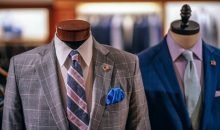
Sin #2 – Not Dressing for the Occasion | Men’s Clothing Style Guides
Dress Codes, Formality, and Knowing What to Wear
The second most-common failing in most men’s clothing is the simple error of showing up for an event either over- or under-dressed.
The former is harder to do than the latter, but still awkward – a tuxedo will stand out anywhere that isn’t black-tie, and a matched suit looks strange outside of formal business settings or particularly dressy social occasions. Conversely, wearing casual trousers and an informal, patterned jacket or no jacket at all can be a serious disadvantage in high-stakes (and high-formality) dealings.
The first and easiest way to be sure of wearing the right thing is to follow the dress code, if one is offered – most social occasions will include this information in an invitation.
Understanding the basic terminology makes wardrobe choices significantly easier:
White Tie
Rarely seen on modern invitations, white tie is the most formal of dress codes. It includes tailcoats, piped trousers, and white waistcoats, and is prohibitively expensive for most men.
Unless you happen to attend jet-set dinners or work for very large charities, you’re unlikely to ever face the white tie code.
Black Tie
Black tie or evening dress means that a black or midnight blue dinner jacket and matching trousers are expected.
A silk bow tie is the only appropriate neckwear (matched to the lapel facings) and patent leather pumps or highly-polished Oxfords are the only shoes that should be worn. The shirt should be white, French-cuffed, and fastened with studs.
Black Tie Optional
Black tie optional is frequently used for ceremonies where the participants will be formally dressed, but want to spare their guests the necessity of owning or renting a tuxedo.
A solid, dark suit with a dark tie and a white undershirt is perfectly appropriate at these events, but anything patterned is too informal. Once again, shoes should be unadorned black Oxfords.
Semi-Formal or Business Dress
Semi-formal or business dress should not be confused with casual or business-casual; a suit is still expected.
The fabric should be dark and patterning kept to a minimum, and the shirt should be unobtrusive and light-colored. A tie is necessary, as are simple, conservative shoes and belt.
Business-Casual or Dress-Casual
Business-casual or dress-casual implies that a tie in particular is optional, and in some circles also indicates that a jacket can be omitted or replaced with a sweater, vest, or similar garment.
The shirt must still be collared, and dress trousers are expected. Any leather dress shoe is appropriate.
Casual
Casual is not anything-goes; any event that bothered to provide a dress code still expects attendees to look neat and well-presented.
However, jeans and casual shirts including polo or golf shirts are appropriate, and dress shorts may also be considered within bounds in hot weather.
Leather sandals, moccasins, or boat shoes may be worn.
When no specific code is given, it may be best to err on the side of conservative dress and wear clothing that can be adjusted if necessary – a suit that proves to be too formal can be dressed down by removing the tie, or the jacket of a casual outfit can be set aside to leave you with a simple collared shirt and trousers.
When more casual codes are in place, resist the temptation to throw on an old polo and a pair of khakis; the result will be looking like every other schlub in the room.
Practice the art of dressing up while dressing down instead: wear light, loose sportcoats with active patterns and softer colors to look casual without losing the flattering shape of a well-cut jacket.
In the summer heat, lightweight materials can keep trousers and long-sleeved shirts a viable option.
Overall, it’s easy to avoid being the wrong-dressed man if you keep your wardrobe versatile enough to conform to different dress codes and pay attention to expectations at public events.
And in general, remember that it’s always safer to be overdressed than under, since clothes can be removed but not added (without a trip home, at least).
TO BE CONTINUED… PART IV
This is just the beginning of your style journey? Stay connected for the upcoming articles.
Please note that much of this publication is based on personal experience and anecdotal evidence.
Although the author and publisher have made every reasonable attempt to achieve complete accuracy of the content in this Guide, they assume no responsibility for errors or omissions.
Also, you should use this information as you see fit, and at your own risk.
Your particular situation may not be exactly suited to the examples illustrated here; in fact, it’s likely that they won’t be the same, and you should adjust your use of the information and recommendations accordingly.
Finally, use your head. Nothing in this Guide is intended to replace common sense, legal, medical or other professional advice, and is meant to inform and entertain the reader.
So have fun and learn to dress sharp!








